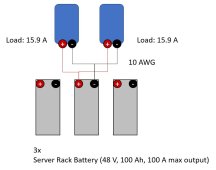JamesTheCrow
New Member
Hi all!
Could you help me out with this, please?
Context:
Goal:
Question:
Will my system be OK if I connect my three server batteries in parallel with only 10 AWG as long as I only draw 15.9 A per connection and only charge at 20 A?
Note: I realize that I'll have to beef up the parallel battery connections to at least be able to deal with the amps coming in from my pv array via the solar charge controllers once I'll have installed them. By then, I'll have swapped the 10 AWG parallel connections with the 4/0 cables.
Thank you.
James
Could you help me out with this, please?
Context:
- I've hooked up one of my three server rack batteries (48 V) to the PV inputs of my two EF Delta Pros to extend overall battery capacity. So far, this has been working well (please see attached diagram). Each Delta Pro is pulling around 15.9 A (which is the maximum each unit is capable of pulling)
- I haven't connected the remaining two batteries to the active battery, yet. I plan to do this with my 4/0 cable, but I haven't sourced the corresponding terminal lugs, yet.
- Nor did I install my panels and solar charge controllers, yet.
- Until I've installed my panels (11 kW) and solar charge controllers, I'm only charging my server rack batteries with a 48 V / 20 A charger.
Goal:
- Until my 4/0 terminal lugs arrive, I'd like to connect the remaining two batteries to my active battery with the 10 AWG cables I have laying around.
- That way, we're going to have enough power to tide us over during power outages. We have a well pump, heat pumps etc. and sometimes outages take 12h - 18h to be fixed.
Question:
Will my system be OK if I connect my three server batteries in parallel with only 10 AWG as long as I only draw 15.9 A per connection and only charge at 20 A?
Note: I realize that I'll have to beef up the parallel battery connections to at least be able to deal with the amps coming in from my pv array via the solar charge controllers once I'll have installed them. By then, I'll have swapped the 10 AWG parallel connections with the 4/0 cables.
Thank you.
James



